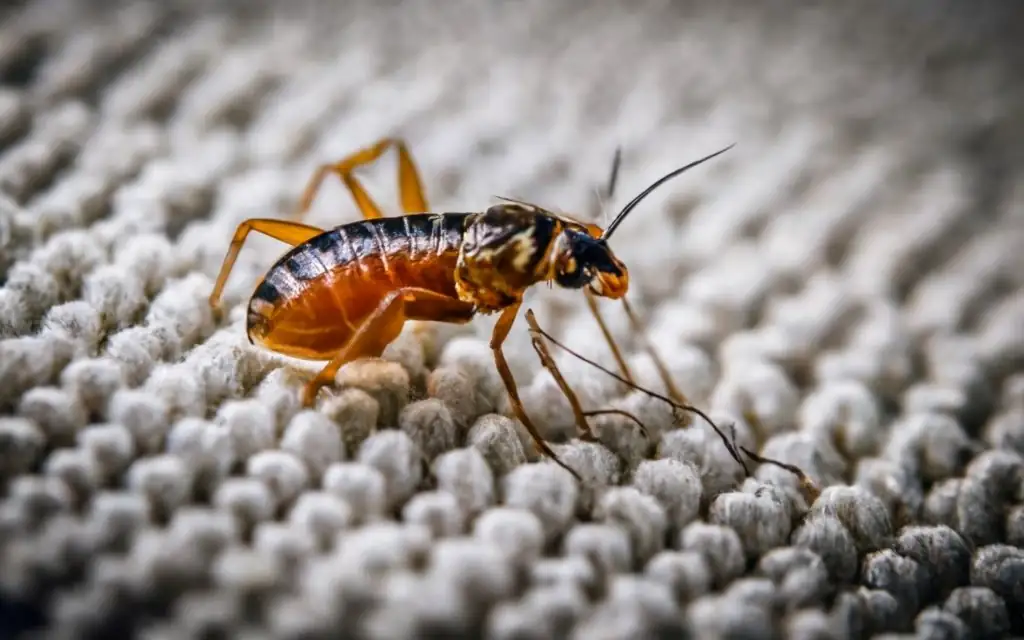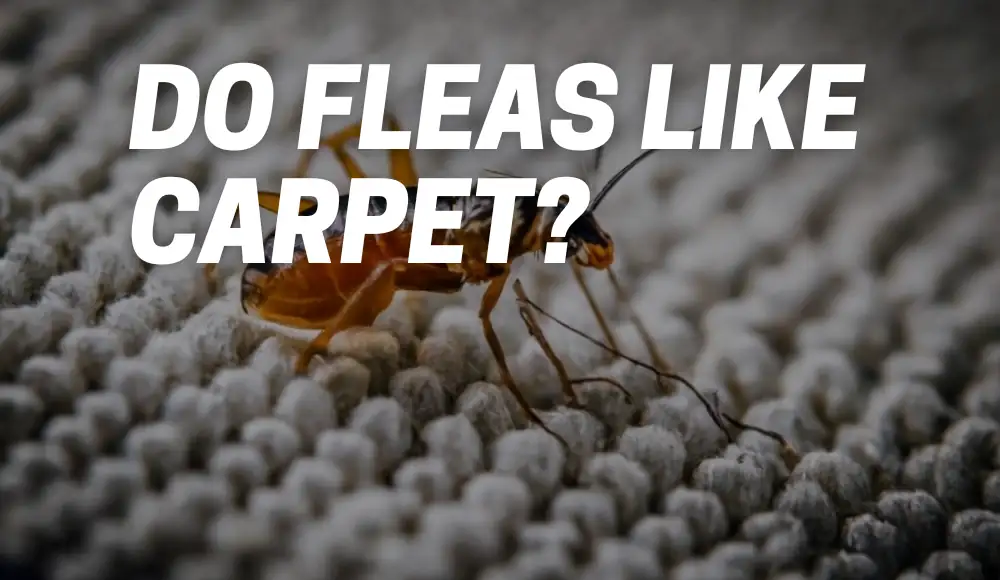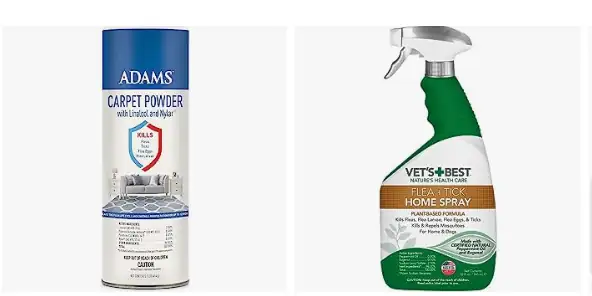Last updated on October 29th, 2023 at 02:25 am
Fleas in carpet, a common household nightmare, can be both a nuisance and a concern for pet owners and anyone trying to maintain a clean and pest-free home. In this comprehensive guide, we will delve deep into the world of fleas and carpets, exploring why these tiny insects are drawn to the plush fibers of your floor covering and what you can do to prevent, detect, and eliminate them.
Do Fleas Live in Carpets?
Fleas in carpet is a common concern, and the answer is a resounding yes. Carpets, with their cozy, warm, and dark spaces, provide an ideal breeding ground for these pesky critters. The first step in understanding and dealing with fleas in your carpet is to comprehend why they find this habitat so inviting.
How and why do fleas choose to live in carpets?
Fleas are drawn to carpets for several reasons. First, they are attracted to the warmth that carpets provide, making it a comfortable environment for breeding. Second, fleas feed on the blood of animals, and pets in your home become easy targets when they spend time on carpets. The fibers of a carpet also offer protection from predators and a place to lay their eggs.
What makes carpets an attractive habitat for fleas?
Carpets are like a smorgasbord for fleas. They offer an abundance of hiding spots, and fleas can easily maneuver through the fibers, making it difficult for you to spot them. The organic matter that accumulates in carpets, such as skin cells and pet hair, provides a convenient food source for these tiny vampires. Plus, the dark and humid environment between carpet fibers is perfect for flea larvae to thrive.
Are There Different Types of Fleas?
Yes, there are various species of fleas, but the most common ones that infest carpets are the cat flea (Ctenocephalides felis) and the dog flea (Ctenocephalides canis). While the names might suggest host preferences, both can infest homes with or without pets.
| Flea Species | Preferred Host | Common Habitats |
|---|---|---|
| Cat Flea (C. felis) | Cats and dogs | Carpets, upholstery, pet bedding, and pet fur |
| Dog Flea (C. canis) | Dogs, occasionally cats | Carpets, upholstery, and outdoor areas |
Here are all the different types and varieties of fleas, each with its own preferences and characteristics.
Flea Species Commonly Encountered
1. Cat Fleas (Ctenocephalides felis)
- Preferred Host: Cats and dogs
- Habitat: Can infest homes, often found in carpets and pet bedding
- Distinctive Feature: Dark reddish-brown with specialized hind legs for jumping
Cat fleas are the most common flea species encountered in both pets and households. They are agile jumpers and can quickly infest carpets and bedding.
2. Dog Fleas (Ctenocephalides canis)
- Preferred Host: Primarily dogs
- Habitat: Found on dogs, in dog bedding, and occasionally infesting homes
- Distinctive Feature: Similar in appearance to cat fleas, making visual identification challenging
Dog fleas closely resemble cat fleas in appearance and behavior. However, they tend to prefer canine hosts.
3. Human Fleas (Pulex irritans)
- Preferred Host: Humans, but can also infest other mammals
- Habitat: Less common in homes; found in clothing, bedding, and cracks in floors
- Distinctive Feature: Smaller and lighter in color than cat or dog fleas
As the name suggests, human fleas primarily target humans, although they can infest other mammals if humans are not available. They are less common in households.
Specialized Flea Species
4. Oriental Rat Flea (Xenopsylla cheopis)
- Preferred Host: Rats
- Habitat: Common in areas with rat infestations, occasionally infests homes
- Distinctive Feature: Dark brown and well-adapted to infesting rats
This flea species is notorious for being a vector of diseases like bubonic plague. They usually infest rats but can affect humans when rats are not available.
5. Sticktight Fleas (Echidnophaga spp.)
- Preferred Host: Poultry and birds
- Habitat: Often found on chickens and other birds
- Distinctive Feature: Small and firmly attached to the host’s skin
Sticktight fleas have a unique habit of embedding themselves in the skin of birds, making them challenging to remove. They rarely affect mammals.
Lesser-Known Flea Varieties
6. Northern Rat Flea (Nosopsyllus fasciatus)
- Preferred Host: Rats
- Habitat: Found in areas with rat infestations
- Distinctive Feature: Dark brown with long legs
Similar to the Oriental rat flea, the northern rat flea targets rats as its primary host.
7. Sand Fleas (Tunga spp.)
- Preferred Host: Humans and animals
- Habitat: Typically found in sandy or muddy areas
- Distinctive Feature: Small and burrow into the skin, causing painful welts
Sand fleas are unique in that they burrow into the skin, causing itching and discomfort. They are often encountered in tropical and subtropical regions.
8. Sticktight Fleas (Echidnophaga gallinacea)
- Preferred Host: Birds and poultry
- Habitat: Found on the skin, particularly around the eyes and wattles of birds
- Distinctive Feature: Firmly attached to the host’s skin
This is another variety of sticktight flea that specializes in infesting birds, especially in the facial areas.
Understanding the specific type of flea infestation you’re dealing with is crucial for effective control and prevention. Whether you’re battling cat fleas on your pets or human fleas in your home, knowledge is your greatest weapon in the war against these persistent parasites.
It’s important to note that these species can interbreed, making it challenging to identify them based on appearance alone.

How to Get Rid of Fleas in Your Carpet
Dealing with fleas in your carpet requires a multi-pronged approach. Here are the steps you can take to eliminate them:
1. Vacuum Thoroughly: Regular and thorough vacuuming is your first line of defense. Be sure to vacuum not only the carpet but also upholstered furniture, pet bedding, and any cracks or crevices where fleas might hide.
2. Wash and Treat Pets: To break the flea life cycle, it’s essential to wash and treat your pets with flea control products. Consult your veterinarian for the best options.
3. Clean and Treat Your Home: Wash pet bedding and any removable fabric items your pet comes into contact with. Use flea control products that are safe for indoor use on carpets, upholstery, and other surfaces.
4. Steam Clean: Consider steam cleaning your carpet, as the high temperatures can kill fleas at various stages of development.
5. Professional Pest Control: In severe infestations, it’s advisable to seek professional pest control services. They have the expertise and equipment to effectively eliminate fleas from your home.
Preventing Fleas in Carpets
Prevention is always better than dealing with a full-blown infestation. To keep your carpets flea-free, consider the following tips:
1. Regular Pet Care: Keep your pets on a consistent flea control program as recommended by your veterinarian.
2. Vacuum Frequently: Regular vacuuming not only removes adult fleas but also their eggs and larvae. Empty the vacuum bag or canister outside to prevent re-infestation.
3. Wash Bedding: Wash pet bedding and any blankets or pillows that your pet uses regularly.
4. Outdoor Control: If your pets spend time outside, consider outdoor flea control methods to reduce the risk of them bringing fleas inside.
5. Professional Carpet Cleaning: Schedule professional carpet cleaning at least once a year to ensure a clean and pest-free environment.
Are Fleas Harmful to Carpets?
Yes, fleas can be harmful to carpets. Their constant activity can lead to wear and tear on the carpet fibers. Moreover, flea excrement can stain the carpet and leave behind an unpleasant odor. If left untreated, a flea infestation can result in costly carpet replacement.
DIY Carpet Flea Treatments
For those who prefer natural or homemade remedies, here are a few DIY options:
1. Baking Soda and Salt Mixture: Sprinkle a mixture of baking soda and salt on your carpet. Leave it for a few hours or overnight, then vacuum thoroughly. The salt dehydrates the fleas, while the baking soda helps neutralize odors.
2. Lemon Spray: Create a lemon spray by boiling sliced lemons in water, allowing it to cool, and then spraying it on your carpet. Fleas dislike the scent of lemon.
3. Diatomaceous Earth: This natural powder is safe for pets and humans but deadly to fleas. Sprinkle it on your carpet, leave it for a few hours, and then vacuum.
Common Myths About Fleas and Carpets
Let’s debunk a few common misconceptions about fleas in carpets:
Myth 1: Fleas can only infest homes with pets.
- Fact: While pets are common hosts, fleas can infest homes without animals, too. They can hitch a ride on clothing or enter through other means.
Myth 2: Vacuuming alone can eliminate all fleas.
- Fact: Vacuuming helps, but it won’t get rid of all fleas or their eggs. A multi-faceted approach is necessary.
Myth 3: Once fleas are gone, they won’t come back.
- Fact: Fleas can reinfest your home if not properly controlled. Prevention is key.
Health Risks Associated with Fleas in Carpets
Flea infestations pose health risks, particularly to pets and young children. Flea bites can cause itching and discomfort, and pets can suffer from flea allergy dermatitis. In severe cases, fleas can transmit diseases.
Comparing Flea Treatment Products for Carpets
| Product | Type | Effectiveness | Safety for Pets |
|---|---|---|---|
| Flea Spray | Chemical | High | Use with caution |
| Diatomaceous Earth | Natural | Moderate | Safe |
| Flea Fogger | Chemical | High | Keep pets away |
| Professional Services | Pest Control | High | Follow guidelines |
Each product has its pros and cons, so it’s essential to choose the one that suits your specific situation and safety concerns.
Professional Carpet Cleaning vs. Flea Removal Services
Professional carpet cleaning can help remove fleas, but it might not eliminate the infestation entirely. For severe cases, opting for specialized flea removal services is often the best solution, as they have the expertise and tools to eradicate fleas thoroughly.
How long do fleas live on carpet?
Fleas can survive on carpets for several weeks to several months, depending on environmental conditions and the availability of hosts.
How do you know if your carpet has fleas?
Signs of a flea infestation in your carpet include:
- Itchy bites on you or your pets
- Flea dirt (tiny black specks) on the carpet
- Fleas hopping on the carpet
Can fleas live in carpets without pets?
Yes, fleas can live in carpets even without pets. They can enter your home through various means, including on clothing or shoes.

Will vacuuming get rid of fleas?
Vacuuming can help eliminate adult fleas, but it may not completely remove all flea eggs and larvae. Emptying the vacuum bag outside and washing your pet’s bedding is crucial for effective flea removal.
Can fleas live in blankets?
Fleas can infest blankets if they have access to them, especially if your pet likes to snuggle in them. Regularly washing and cleaning pet bedding can help prevent this.
How to get rid of fleas in carpet naturally
To naturally get rid of fleas in your carpet, use methods like diatomaceous earth, baking soda, and lemon sprays, as mentioned earlier.
Flea treatment for carpet safe for pets
Diatomaceous earth and lemon sprays are generally considered safe for pets when used as directed. However, always exercise caution and consult with your veterinarian if you have concerns.
Does baking soda kill fleas in carpet?
Baking soda can help dry out and kill fleas in your carpet by causing dehydration. It’s an effective and natural remedy for flea control.
How to see fleas in carpet
Fleas are tiny and can be hard to spot. You may need to get down on your hands and knees and part the carpet fibers to look for them. Alternatively, a fine-toothed flea comb can help you collect and identify them.
Can fleas live in carpet and furniture?
Fleas can live in both carpet and furniture, especially if they have access to these areas through pets or people.
Do fleas live in clothes?
Fleas can infest clothing if they are carried there by pets or if you come into contact with flea-infested areas. Regularly washing and treating infested clothing is essential.
In conclusion, fleas in carpets are a common household problem that can affect anyone, pet owner or not. Understanding their behavior, prevention, and treatment methods is key to maintaining a flea-free home. With the right knowledge and actions, you can bid farewell to these unwanted roommates and enjoy a pest-free, cozy living space.
Remember: If you suspect a severe flea infestation, it’s advisable to seek professional help. For more information and guidance on fleas, consult authoritative sources like the Centers for Disease Control and Prevention and National Pest Management Association.
Don’t let fleas take over your home – take control and restore your peace of mind.




